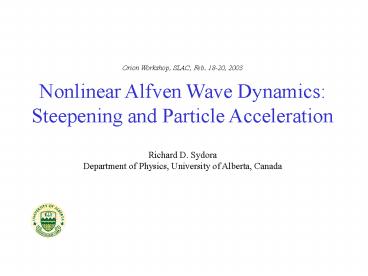Orion Workshop, SLAC, Feb. 18-20, 2003 - PowerPoint PPT Presentation
1 / 16
Title:
Orion Workshop, SLAC, Feb. 18-20, 2003
Description:
Steeping dispersiodissipation (eg. wave-particle trap) ... Wave-particle trapping time (dissipation) Ttr ~ (w / kII Vperp) [sinq (Bw/Bo)]-1/2 ... – PowerPoint PPT presentation
Number of Views:24
Avg rating:3.0/5.0
Title: Orion Workshop, SLAC, Feb. 18-20, 2003
1
Orion Workshop, SLAC, Feb. 18-20,
2003 Nonlinear Alfven Wave Dynamics Steepening
and Particle Acceleration Richard D.
Sydora Department of Physics, University of
Alberta, Canada
2
Outline
Alfven waves in space/astrophysical plasmas
Simulation Approaches Dynamical Evolution of
Nonlinear Alfven Waves - perpendicular and
oblique propagation Particle Acceleration in
Nonlinear Wave Fields Possible Connection to
Orion Facility
3
Alfven Waves in Space/Astrophysical Plasmas
- Alfven waves are a fundamental normal mode of
plasma observed in laboratory and space plasmas - Nonlinear Alfvenic structures populate various
regions of the solar wind and magnetosphere
good satellite observations (Freja and FAST
satellites) - Connection to particle acceleration has been made
considered serious candidate as an auroral
region accelerator (1eV ? 10keV)
4
- Interesting questions
- What are the limits of Alfven-wave based
accelerators? - What are the properties of Alfven waves in
extreme astrophysical plasma conditions? - Can tests of these ideas be implemented in the
lab and are the results scalable?
5
Simulation Approaches
- Fully nonlinear relativistic EM PIC
- good for high frequency, short-time scales
- used in shock studies (Aarons, Langdon, Lembege,
Dawson, Ohsawa, Buneman , et al.) - Hybrid approach
- -massless electrons, particle ions (Winske,
Quest, et al.) - -fluid ions, particle electrons
- 2-species low frequency relativistic EM PIC
- -implicit and semi-implicit time stepping
(Langdon, Lapenta, Brackbill, Tanaka, et al.) - -most suitable for Alfven wave dynamics
6
Simulation Model for Nonlinear Magnetosonic Wave
Propagation
- Relativistic electromagnetic particle-in-cell
(PIC) - Full electron and ion dynamics since emphasis on
detailed electron motion - 1D spatial, 3D velocities
- External B-field in (x,z) plane
- Wave propagation in x-direction
B
z
k
y
q
x
(Ref. Ohsawa, et al., 99)
7
Dynamical Evolution Finite Amplitude Pulse
- Consider finite amplitude disturbance, wavenumber
k - Simplified magnetosonic wave linear dispersion
relation (w k VA ( 1 c2k2/2wpe2 ) ) - Since propagation velocity depends on intensity
of wave, nonlinear evolution becomes a balance
of - Steeping ??dispersion ?? dissipation (eg.
wave-particle trap) - Issue of stationary versus non-stationary
structure important
8
- Propagation characteristics (Barnes, 76)
- BT Bw Bo
- Steepening time
- Ts (2/3w) (Bw / Bo)
- Wave-particle trapping time (dissipation)
- Ttr (w / kII Vperp) sinq (Bw/Bo)-1/2
9
Magnetosonic Solitary Wave Pulse
Perturbation theory result (weak amplitude
limit) -2-fluid non-relativistic theory
10
Magnetosonic Solitary Pulse Propagation
11
Quasi-perpendicular Magnetosonic Shock
- Wave frame (d/dt 0)
- vx c Eyo / B(x)
- Mgt1, shock front forms, charge separation
generates Ex field
B
Eyo
z
B,f,n
y
vx
q
(-MvA)
x
12
M 2 (low Mach number)
13
Electron Phase Space and Ex and Ey Fields
14
Cross-Field Particle Acceleration
- Nonlinear wave structure mainly determined by the
electrons - Electric potential
- ef K (mi / 2) M2VA2
- with Ex f / D and D c / wpe
- ? vey -cEx/B
- Particle acceleration (vph x B mechanism)
- Ions and electrons trapped in Ex field, normal to
the wavefront. Acceleration up to the Ex x B
drift - vph eEx/mw and vmax cEx / B
- (Katsouleas, Dawson, Lembege, Ohsawa, Sugihara,
et al.)
15
Connection to Orion Facility
- Electron and positron beam convergent into a
relativistic plasma - 1m long column consisting of solenoid and
undulator fields. These fields could be designed
to emulate the magnetic field shock structure - Vph x B cross field particle acceleration
mechanism could be used to boost electron and
positron energies - Spectrometer would be used to construct energy
spectrum and power law - 3D PIC simulations could be used to optimize
field gradients
16
Summary
- Solitary magnetosonic and quasi-perpendicular
magnetosonic shocks can be used as effective
particle accelerators - Generation of wakefields possibly leads to rear
acceleration into the shock front which gets a
further energy boost (under investigation) - Extension of these results to very high Mach
number may lead to considerable change of physics
as compared with low Mach number case, typically
found in the Earths magnetosphere (solar wind)






























